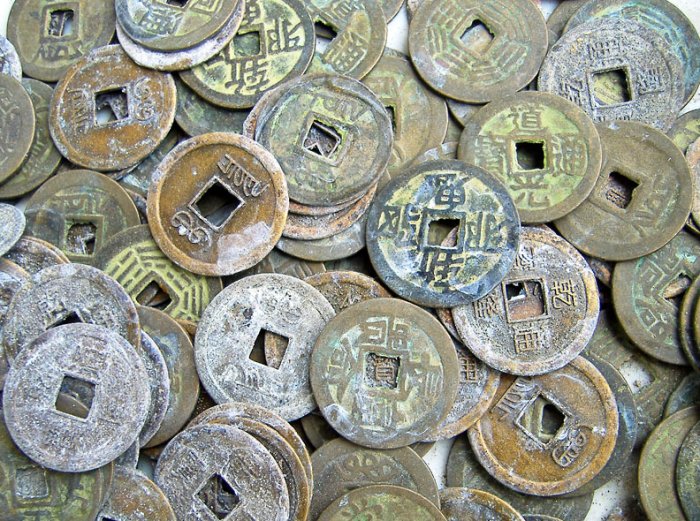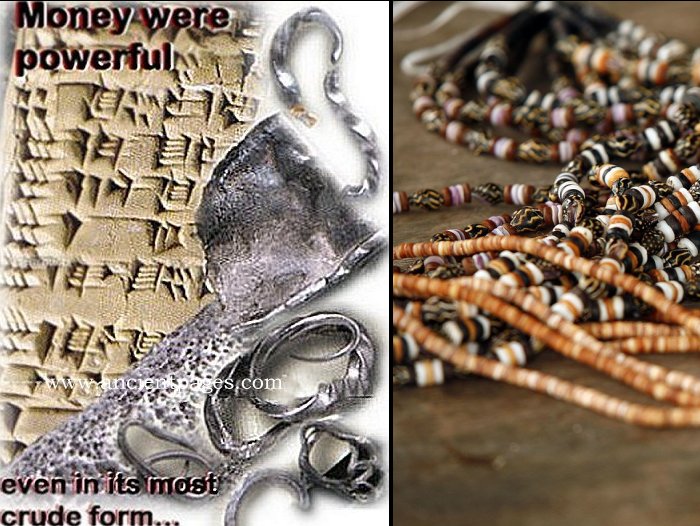Our Lives Have Always Been Manipulated By Money – Part 1
A. Sutherland - AncientPages.com - For 4500 years, human life was controlled and even manipulated by money. Ever since ancient times, money has played a central role in people's lives, regardless of whether payment has been rare shells, worthless iron coins, small springs, or stamped precious metal pieces.
Chinese bronze coins. Image credit: Plismo - CC BY-SA 3.0
In Greece, for example, prehistoric falsifiers covered cheap copper with a thin layer of gold and tin they used to cover with the thin layer of silver.
We go back 4500 years and find that silver rods were the world's first money. They were introduced in Mesopotamia to smooth the progress of trade. The origin of money is hidden in the far distant past, but for the first time, money was mentioned in writings in Mesopotamia (today: Iraq).
According to ancient cuneiform tablets, pure silver was the first standardized payment. They were shaped like rods cut off and weighed when a business was ready to be implemented.
The introduction of silver most probably took place for purely practical reasons. Trade was prevalent in the highly developed Mesopotamia, and natural objects were often heavy and unwieldy, so it was much easier to take small silver rods than oxen or cereal. According to historians, cuneiform tablets were invented for easier bookkeeping of the growing number of trade transactions.
For thousands of years, China has been using gold, silver, and even copper money, which were in circulation besides the well-known cowrie shells.
Even in those distant times, a very "elementary process of minting was in vogue; and the coins were known as the round money, bell-shaped money, and the knife-shaped money." (S.R. Wagel, "Chinese Currency And Banking")
During the early periods of China's history, the shells constituted the only medium of exchange.
About 3500 years ago, the Chinese began to use small shells as money. Shells were perfect money for the Chinese people. They were lightweight, durable, small, easy to carry, and impossible to falsify.
The extent of shell currency is currently unclear, but it was probably prevalent. As the Chinese writing system developed, it used the shell sign as the symbol for 'money.' Similarly, shells were included in characters, including such terms like "buy," "sell," and "barter."
The shells, very coveted by people living along the Indian Ocean until the 1900s, were used to pay for groceries, including food. On the other hand, the Chinese were not the only ones who paid with shells', which also suffered inflation like our modern currency.
For example, in remote regions of Uganda, a wife cost only two shells (!) in the 1700s. As a result of inflation, more than 1000 shells had to be paid to buy a wife in 1860.
People improved the roads to the sea, and many more shells came into circulation, and their value decreased. Coins of metal were known in ancient Egypt, though wealthy merchants dealing with foreign partners almost exclusively limited their use.
The most common payment among ordinary people was cereal. A monthly salary of around 200 kg was used in barter trade to obtain other goods.
Right: Papua New Guinea shell money. Image credit: Department of Foreign Affairs and Trade - SOLS0344- CC BY 2.0
Egyptians could put grain, receive or borrow some if necessary, while banks' goal was to stimulate trade, built up power, and a network of public cereal. Bank customers received a receipt for their deposits and loans and could take out or pay in other cereal banks. The receipts were also used as payment in trade.
To prevent fraud in the local bank branches, the central bank in Alexandria had copies of all service accounts.
Once upon a time, there was an Iron Age kingdom in western Asia Minor known as the Kingdom Of Lydia. Lydia was considered one of the wealthiest kingdoms of antiquity when it replaced the metal lumps with beautifully minted coins. The Lydian money was called the "Adam of coins" because it inspired later periods of coins in Europe and the Middle East. The Kingdom of Lydia was not more extensive than a city-state, but that seemingly insignificant kingdom left behind a legacy that would change history: coins.
There were already various forms of money in Egypt, China, and other great ancient kingdoms. Still, in Lydia, it was recognized the importance of a small and manageable payment for the first time.
To eliminate the great inconveniences of non-standardized money, banks and goldsmiths began to convert metal into standard coins, giving them specified shape, weight, and fineness. Circa 640 BC, the Lydian kings were the first to strike average weight and common size coins. They also marked them with their sigils to ensure the metal's authenticity. Additionally, they counted the coins!
Coins revolutionized trade because Lydian merchants no longer needed to devote their precious time weighing silver and gold pieces or exploring the metal's purity.
"Virtually all coinage in use today is the progeny" of what the Lydians initiated. (Porteous, "The Nature of Coinage")
Written by – A. Sutherland AncientPages.com Staff Writer
Copyright © AncientPages.com All rights reserved. This material may not be published, broadcast, rewritten or redistributed in whole or part without the express written permission of AncientPages.com
Expand for referencesReferences:
G. Davies, "History of Money"
S.R. Wagel, "Chinese Currency And Banking"
More From Ancient Pages
-
 Nazar Amulet – Blue Color Wards Off The Evil Eye According To Ancient Belief
Ancient Symbols | Mar 13, 2018
Nazar Amulet – Blue Color Wards Off The Evil Eye According To Ancient Belief
Ancient Symbols | Mar 13, 2018 -
 Submerged Roman Villa Discovered On The Coast Of Cerveteri, Italy
Archaeology | Jun 6, 2024
Submerged Roman Villa Discovered On The Coast Of Cerveteri, Italy
Archaeology | Jun 6, 2024 -
 On This Day In History: Crew Of Discovery Launches Mutiny Against Captain Henry Hudson – On June 22, 1611
News | Jun 22, 2016
On This Day In History: Crew Of Discovery Launches Mutiny Against Captain Henry Hudson – On June 22, 1611
News | Jun 22, 2016 -
 Pancho Villa – Mexico’s Robin Hood – A Ruthless Bandit Or A Hero?
Featured Stories | Jul 1, 2023
Pancho Villa – Mexico’s Robin Hood – A Ruthless Bandit Or A Hero?
Featured Stories | Jul 1, 2023 -
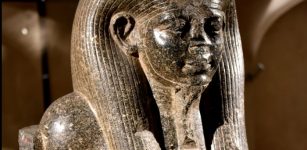 Hapi: Early Egyptian God Of The Nile And Bringer Of Fertility, Abundance And Life
Egyptian Mythology | Mar 20, 2019
Hapi: Early Egyptian God Of The Nile And Bringer Of Fertility, Abundance And Life
Egyptian Mythology | Mar 20, 2019 -
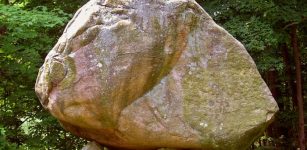 Mystery Of The Giant Boulder In North Salem
Featured Stories | Aug 8, 2019
Mystery Of The Giant Boulder In North Salem
Featured Stories | Aug 8, 2019 -
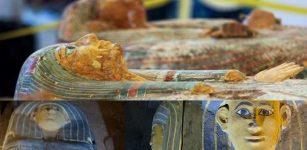 Three 3,500-Year-Old Painted Wooden Coffins Discovered In Luxor, Egypt
Archaeology | Dec 3, 2019
Three 3,500-Year-Old Painted Wooden Coffins Discovered In Luxor, Egypt
Archaeology | Dec 3, 2019 -
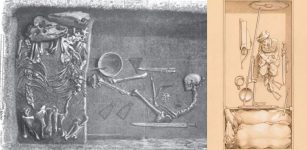 Birka Warrior Was A Woman – DNA Reveals
Archaeology | Feb 15, 2018
Birka Warrior Was A Woman – DNA Reveals
Archaeology | Feb 15, 2018 -
 Mysterious Disappearance Of Philip Christoph Königsmarck – Where Is The Swedish Count Buried?
Featured Stories | Feb 21, 2024
Mysterious Disappearance Of Philip Christoph Königsmarck – Where Is The Swedish Count Buried?
Featured Stories | Feb 21, 2024 -
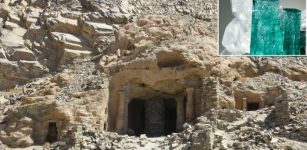 Emerald Production In Eastern Desert Of Roman Egypt – New Evidence
Archaeology | Apr 16, 2021
Emerald Production In Eastern Desert Of Roman Egypt – New Evidence
Archaeology | Apr 16, 2021 -
 Sacred Island Ukonsaari Of The Sami People Will Be Respected – Tourism Company Ends Landings On The Island
News | Nov 14, 2019
Sacred Island Ukonsaari Of The Sami People Will Be Respected – Tourism Company Ends Landings On The Island
News | Nov 14, 2019 -
 Archaeological Evidence Ancient Egyptians Visited South America
Civilizations | Jan 7, 2020
Archaeological Evidence Ancient Egyptians Visited South America
Civilizations | Jan 7, 2020 -
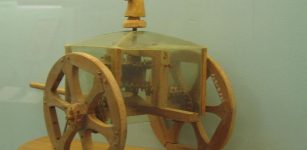 Remarkable South-Pointing Chariot – Ancient Cybernetic Machine Invented 1,700 Years Ago Is An Engineering Masterpiece
Ancient Technology | Jul 17, 2014
Remarkable South-Pointing Chariot – Ancient Cybernetic Machine Invented 1,700 Years Ago Is An Engineering Masterpiece
Ancient Technology | Jul 17, 2014 -
 Mystery Of The Ancient Lost Megalithic City Of Nhambiquaras And The Curious Roman Figurine
Featured Stories | Mar 4, 2022
Mystery Of The Ancient Lost Megalithic City Of Nhambiquaras And The Curious Roman Figurine
Featured Stories | Mar 4, 2022 -
 Major Underwater Archaeological Find On The Western Coast Of Sicily – Artifacts From The Battle Of The Egadi Islands?
Archaeology | Sep 11, 2023
Major Underwater Archaeological Find On The Western Coast Of Sicily – Artifacts From The Battle Of The Egadi Islands?
Archaeology | Sep 11, 2023 -
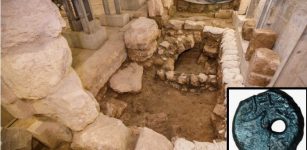 New Evidence Of The Destruction Of The Second Temple In The City Of David
Archaeology | Aug 5, 2023
New Evidence Of The Destruction Of The Second Temple In The City Of David
Archaeology | Aug 5, 2023 -
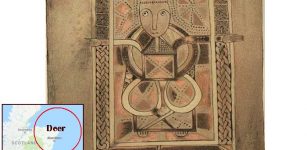 Book Of Deer And The Lost Scottish Monastery – Archaeologists Report New Finds
Archaeology | Jan 10, 2018
Book Of Deer And The Lost Scottish Monastery – Archaeologists Report New Finds
Archaeology | Jan 10, 2018 -
 DNA Reveals Participants In California’s Gold Rush Dined On Salted Atlantic Cod
Archaeology | Jan 7, 2022
DNA Reveals Participants In California’s Gold Rush Dined On Salted Atlantic Cod
Archaeology | Jan 7, 2022 -
 3,000-Year-Old Geoglyphs May Depict The Heavens
Archaeology | Jun 25, 2018
3,000-Year-Old Geoglyphs May Depict The Heavens
Archaeology | Jun 25, 2018 -
 Curious Bannerstones Used By Prehistoric Native Americans For Unknown Purpose
Artifacts | May 31, 2021
Curious Bannerstones Used By Prehistoric Native Americans For Unknown Purpose
Artifacts | May 31, 2021

